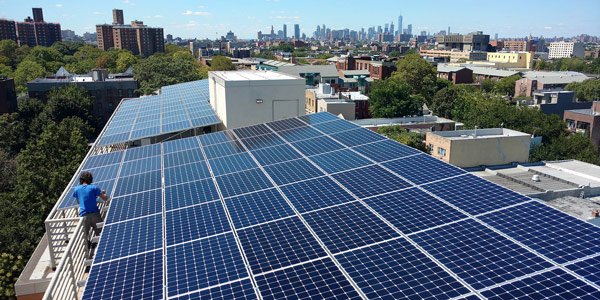By Michael Kuser
RENSSELAER, N.Y. — A NYISO proposal to disqualify some holders of renewable energy credit (REC) contracts from getting paid carbon charges risks undermining the state’s energy market, stakeholders heard on Monday.
In July, the ISO proposed that renewable generators holding REC contracts signed on or before Jan. 1, 2020, be ineligible to collect the carbon pricing portion of wholesale market energy prices. (See NY Sets Carbon Pricing Timeline, Reviews Progress.)
“This would be the first time the NYISO has taken an action that goes against existing contracts,” said Mark Reeder, representing the Alliance for Clean Energy New York (ACE NY), which promotes renewables and energy efficiency. “It will increase uncertainty and decrease the willingness of future investors to invest in New York. It’s not very helpful in that regard.”
Reeder delivered a presentation on the topic Aug. 20 to the Integrating Public Policy Task Force (IPPTF), the group exploring how to incorporate the cost of CO2 emissions into the ISO’s markets to support the state’s nuclear plants.
NYISO’s proposal aims to limit customer impacts of the carbon charge by helping reduce or eliminate what it terms “double payments” to renewable resources. According to Reeder, that tells investors that it’s financially risky to develop energy resources that lower carbon emissions in New York. All carbon-free generators should receive the full market energy price, including carbon price effects, he said.
Reeder said the ISO should defer to the state’s Public Service Commission because double payments are a matter of public policy, not market design. REC contracts for 2019 solicitations and beyond should align with the indexed price approach that the PSC approved for offshore wind REC contracts (ORECs), he said. (See NYPSC: Offshore Wind ‘Ready for Prime Time’.)
The task force should separately estimate the consumer impacts of receiving the carbon price for existing REC contract holders, nuclear plants under the zero-emission credits regime, combined cycle gas turbines and state-owned hydro generation, Reeder said.
Couch White attorney Michael Mager, who represents Multiple Intervenors, a coalition of large industrial, commercial and institutional energy customers, said that, “given the amount of potential double payment at stake here, no one should take it as a given that carbon pricing moves forward absent this issue being resolved.”
Making consumers pay renewable developers higher energy prices to reflect carbon pricing, while also requiring them to pay the same developers for RECs for carbon-free generation attributes, is a clear double payment that must be addressed by NYISO or the PSC, he said.
Renewable developers have benefited from other rule changes, including the Clean Energy Standard and the PSC’s decision to offer three-year contracts to maintain the operation of existing renewable generation facilities (Case 17-E-0603), Mager said. “So these things happen all the time, and I would venture to say that the vast majority of rule changes in the last five to 10 years have been extremely favorable to renewable developers.”
Evaluating a Carbon Charge
Daymark Energy Advisors’ Marc Montalvo, representing the New York Department of State’s Utility Intervention Unit, delivered the preliminary results of a study evaluating NYISO’s proposed carbon charge in outcomes between two cases, a “status quo” case assuming state policies are met but the carbon charge is not implemented, and a case with the carbon charge. The study period included each year between 2020 and 2025, in addition to 2030 and 2035.
The proposed carbon charge could result in slightly lower CO2 emissions in the Eastern Interconnection but higher emissions in New York, the study found. Low capacity prices and the large number of renewables being added to the system now may push prices too low to support new renewable entry within the study period, he said.
“Because so much new generation is being added, we thought it prudent to look at the proposal,” Montalvo said. “We used slightly different assumptions from the ISO’s; for example in the dynamic modeling of proposed border adjustments, which don’t capture likely changes in behavior.”
Several stakeholders questioned the usefulness of such a shuffling exercise, as the ISO’s straw proposal intends to be carbon-agnostic to resources outside New York: Imports would earn the locational-based marginal price but not the carbon adder; similarly, external loads would buy New York energy at the LBMP without paying the carbon charge.
Montalvo said all the modeled regions add and take away resources based on policy and economic reasons, and “we’ve seen resources stick around for years for reasons impossible to know from the outside.”
He claimed that his group’s “very detailed model of the Eastern Interconnection” provides valuable insight into the effects of pricing carbon into New York’s wholesale electricity markets.
Monday’s meeting materials also included the task force charter as approved by the Business Issues Committee on Aug. 13. (See NYISO Business Issues Committee Briefs: Aug. 13, 2018.)
Stakeholders also had access to two comments submitted on the ISO’s carbon pricing straw proposal — one from “private retired citizen” Roger Caiazza, and another from Consolidated Edison. (See Stakeholders Annoyed by NYISO Carbon Price Draft.)
The task force next meets Aug. 27 at NYISO headquarters.






